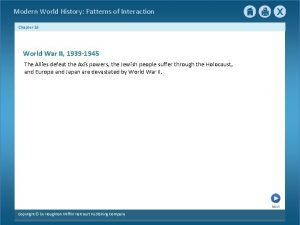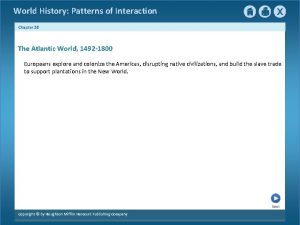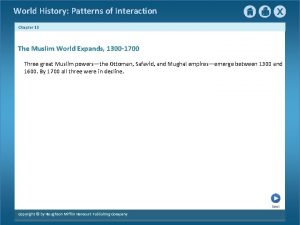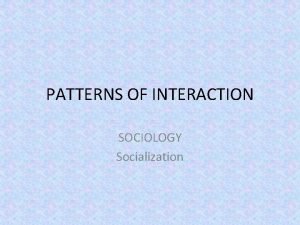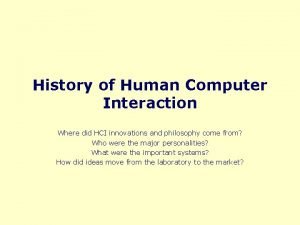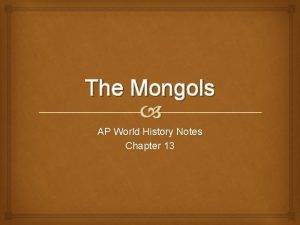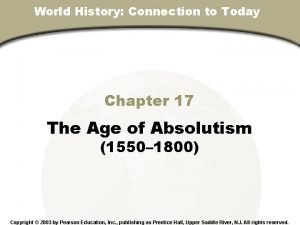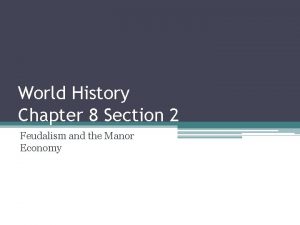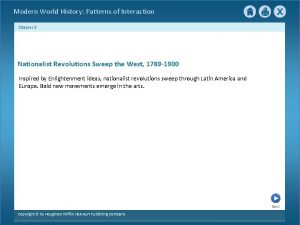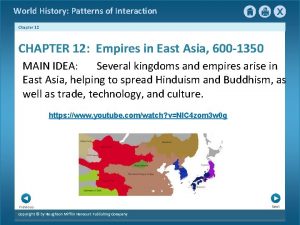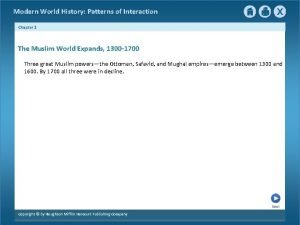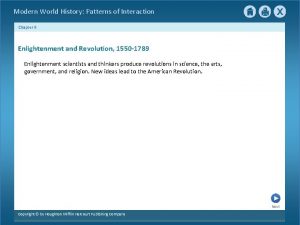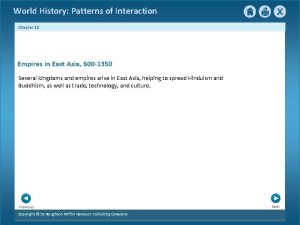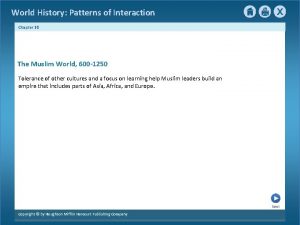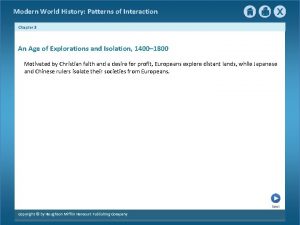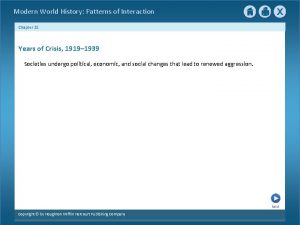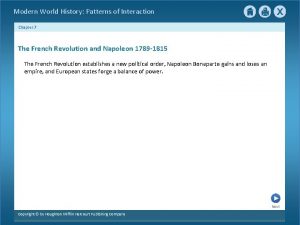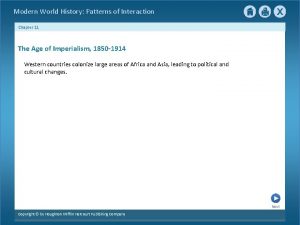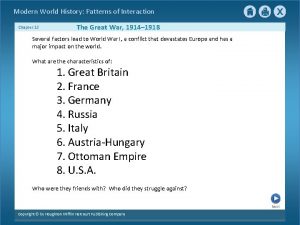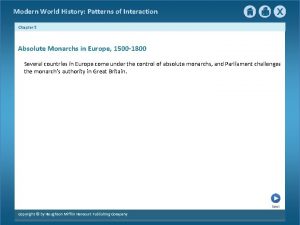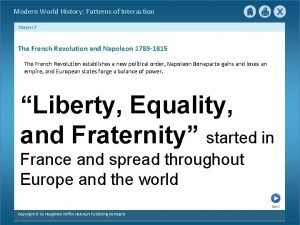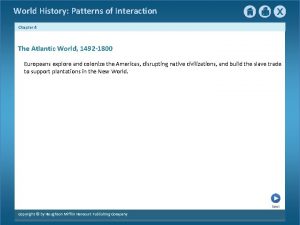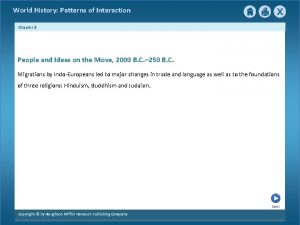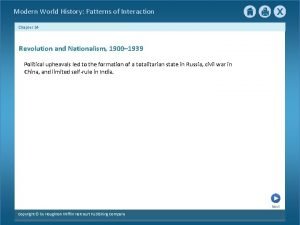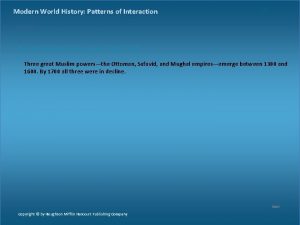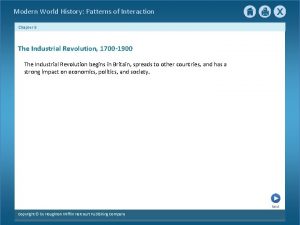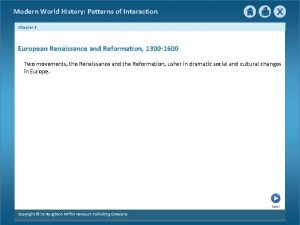World History Patterns of Interaction Chapter 18 The

























- Slides: 25

World History: Patterns of Interaction Chapter 18 The Muslim World Expands, 1300 -1700 Three great Muslim powers—the Ottoman, Safavid, and Mughal empires—emerge between 1300 and 1600. By 1700 all three were in decline. Next Copyright © by Houghton Mifflin Harcourt Publishing Company

World History: Patterns of Interaction Chapter 18 The Muslim World Expands, 1300 -1700 SECTION 11 SECTION The Ottomans Build a Vast Empire SECTION 22 SECTION CASE STUDY: Cultural Blending SECTION 33 SECTION The Mughal Empire in India Previous Copyright © by Houghton Mifflin Harcourt Publishing Company Next

World History: Patterns of Interaction Chapter 18 Section-1 The Ottomans Build a Vast Empire The Ottomans establish a Muslim empire that combine many cultures and lasted for more than 600 years. Previous Copyright © by Houghton Mifflin Harcourt Publishing Company Next

World History: Patterns of Interaction Chapter 18 Section-1 The Ottomans Build a Vast Empire Turks Move into Byzantium Turkish Warriors • Many Turks live in Anatolia, on edge of Byzantine Empire • Many see themselves as ghazis—warriors who fight for Islam Osman Establishes a State • From 1300 to 1326, Osman, successful ghazi, builds state in Anatolia • Europeans call him Othman and followers Ottomans • Ottomans win battles because they use muskets and cannons • Successors expand state through alliances and land buying Previous Copyright © by Houghton Mifflin Harcourt Publishing Company Continued… Next

World History: Patterns of Interaction Chapter 18 Section-1 Turks Move into Byzantium {continued} Osman Establishes a State • Orkhan, Osman’s son, declares himself sultan—overlord • In 1361, Turks conquer Adrianople • Ottomans rule fairly over conquered peoples Timur the Lame Halts Expansion • Timur the Lame —Tamerlane—rises to power in Central Asia • Timur defeats Ottomans in 1402, burning Baghdad Previous Copyright © by Houghton Mifflin Harcourt Publishing Company Next

World History: Patterns of Interaction Chapter 18 Section-1 Powerful Sultans Spur Dramatic Expansion Murad II • Murad II begins expansion Mehmed II Conquers Constantinople • Murad’s son, Mehmed II, conquers Constantinople in 1453 • Opens city to Jews, Christians, and Muslims and rebuilds Ottomans Take Islam’s Holy Cities • In 1512, Selim the Grim, Mehmed’s grandson, comes to power • He defeats Persian Safavids and pushes into North Africa • Conquers Mecca, Medina, and Cairo: important Muslim cities Previous Copyright © by Houghton Mifflin Harcourt Publishing Company Next

World History: Patterns of Interaction Chapter 18 Section-1 Suleyman the Lawgiver A Great Ruler • Suleyman the Lawgiver , Selim’s son, rules from 1520 to 1566 The Empire Reaches Its Limits • Suleyman conquers Belgrade (1521) and Rhodes (1522) • Ottomans control eastern Mediterranean • Turks take North African coastline, control inland trade routes • Suleyman’s forces advance to Vienna • By 1526, Ottoman Empire is the largest in the world Previous Copyright © by Houghton Mifflin Harcourt Publishing Company Continued… Next

World History: Patterns of Interaction Chapter 18 Section-1 Suleyman the Lawgiver {continued} Highly Structured Social Organization • Suleyman creates law code, reduces bureaucracy, simplifies taxation • Army uses devshirme —drafts boys from conquered lands • Trains 30, 000 elite soldiers—janissaries —loyal only to the sultan • Jews and Christians allowed to practice own religion Cultural Flowering • Suleyman’s broad interests lead to flourishing of arts, learning • Sinan, brilliant architect, designs magnificent Mosque of Suleyman Previous Copyright © by Houghton Mifflin Harcourt Publishing Company Next

World History: Patterns of Interaction Chapter 18 Section-1 The Empire Declines Slowly Gradual Fall • Suleyman kills one son and exiles another • Third son inherits throne but rules weakly • Later sultans kill their brothers and leave their sons uneducated • Long line of weak sultans leads to empire’s eventual fall Previous Copyright © by Houghton Mifflin Harcourt Publishing Company Next

World History: Patterns of Interaction Chapter 18 Section-2 Cultural Blending Case Study: The Safivid Empire The Safavid Empire produce a rich and complex blended culture in Persia. Previous Copyright © by Houghton Mifflin Harcourt Publishing Company Next

World History: Patterns of Interaction Chapter 18 Section-2 Cultural Blending Case Study: The Safavid Empire Patterns of Cultural Blending in Persia • Between 16 th and 18 th centuries a Shi’ite Muslim dynasty ruled Persia • Safavid Empire—Shi’ite Muslim dynasty from 16 th to 18 th centuries Causes of Cultural Blending • Changes occur through migration, conquest, trade, or religion Results of Cultural Blending • Changes in language, religion, government, use of technology • Racial and ethnic blending, intermarriage • Cultural styles adapted into arts and architecture Previous Copyright © by Houghton Mifflin Harcourt Publishing Company Next

World History: Patterns of Interaction Chapter 18 Section-2 The Safavids Build an Empire Safavid Origins • Begins as religious order named for founder • Safavids concentrate on building powerful military Isma’il Conquers Persia • Fourteen-year-old Isma’il conquers Iran by 1451 • Takes title of shah—king • Makes Shi’a Islam official religion; kills Sunnis • Son, Tahmasp, greatly expands empire Previous Copyright © by Houghton Mifflin Harcourt Publishing Company Next

World History: Patterns of Interaction Chapter 18 Section-2 A Safavid Golden Age Abbas the Great • Shah Abbas—Abbas the Great—takes throne in 1587 Reforms • Helps create a thriving Safavid culture • Reforms military and government; brings in Christian trade A New Capital • Esfahan—new capital—is one of the world’s most beautiful cities Art Works • Chinese artisans blend Chinese and Persian styles Carpets • Carpet weaving becomes national industry Previous Copyright © by Houghton Mifflin Harcourt Publishing Company Next

World History: Patterns of Interaction Chapter 18 Section-2 The Dynasty Declines Quickly The Safavid Empire Weakens • Abbas kills and blinds his ablest sons • Safi, Abbas’s incompetent grandson, leads to empire’s decline • By 1722, the empire is losing land to the Ottomans and Afghans • Nadir Shah Afshar expands the empire, but it falls apart in 1747 Previous Copyright © by Houghton Mifflin Harcourt Publishing Company Next

World History: Patterns of Interaction Chapter 18 Section-3 The Mughal Empire in India The Mughal Empire brings Turks, Persians, and Indians together in a vast empire. Previous Copyright © by Houghton Mifflin Harcourt Publishing Company Next

World History: Patterns of Interaction Chapter 18 Section-3 The Mughal Empire in India Early History of the Mughals Mongol Invaders • Mughals, or Mongols, invade northwestern India Conflict • Muslims and Hindus fight for almost 300 years • In 1000, loose empire of Turkish warlords—Delhi Sultanate—forms Delhi Sultanate • Sultans rule from Delhi between 13 th and 16 th centuries • Timur the Lame destroys Delhi in 1398 Previous Copyright © by Houghton Mifflin Harcourt Publishing Company Next

World History: Patterns of Interaction Chapter 18 Section-3 Early History of the Mughals Babur Founds an Empire • Babur becomes king of small land in Central Asia at 11 • Is dethroned and driven south into India • Army conquers much of northern India, forming Mughal Empire • Son Humayun loses most of the territory Babur conquered • Babur’s grandson succeeds Humayan Previous Copyright © by Houghton Mifflin Harcourt Publishing Company Next

World History: Patterns of Interaction Chapter 18 Section-3 Akbar’s Golden Age Babur’s Grandson • Akbar—“Greatest One”—rules India from 1556 to 1605 A Military Conqueror • Akbar uses cannons; names native Indians as officers A Liberal Ruler • Akbar allows religious freedom and abolishes tax on non-Muslims • Akbar allows all people a chance to serve in high government office • Hindu finance minister develops better tax plan; income grows • Akbar gives land to his officials, then reclaims it when they die Previous Copyright © by Houghton Mifflin Harcourt Publishing Company Continued… Next

World History: Patterns of Interaction Chapter 18 Section-3 3 Akbar’s Golden Age {continued} A Flowering of Culture • Many cultures blend, mixing art, education, politics, and language • New languages like Hindi and Urdu emerge The Arts and Literature • Book illustrations, called miniatures, flourish • Hindu literature reemerges during Akbar’s rule Architecture • New architectural style named for Akbar develops Previous Copyright © by Houghton Mifflin Harcourt Publishing Company Next

World History: Patterns of Interaction Chapter 18 Section-3 Akbar’s Successors Jahangir and Nur Jahan • Akbar’s son, Jahangir, allows wife Nur Jahan to control government • Nur Jahan appoints her father prime minister • Nur Jahan favors son Khusrau over other sons • Khusrau rebels, supported by Sikhs, nonviolent religious group • Sikhs become targets of Mughal hatred Previous Copyright © by Houghton Mifflin Harcourt Publishing Company Next

World History: Patterns of Interaction Chapter 18 Section-3 Akbar’s Successors {continued} Shah Jahan • Shah Jahan—Jahangir’s son and successor, marries Persian princess • Assassinates all competitors for throne • His wife dies while giving birth to her 14 th child in 1631 • Taj Mahal—huge marble tom Shah Jahan builds for his wife • Taj Mahal is one of the most beautiful buildings in the world Previous Copyright © by Houghton Mifflin Harcourt Publishing Company Next

World History: Patterns of Interaction Chapter 18 Section-3 Akbar’s Successors {continued} The People Suffer • People suffer paying for wars and monuments • Shah Jahan’s third son—Aurangzeb—imprisons father and takes over Aurangzeb’s Reign • Rules between 1658 and 1707; expands empire to its largest • Strictly enforces Islamic law and attempts to get rid of Hindus • Hindus rebel and Sikhs become militant • Levies oppressive taxes on Hindus, causing more rebellion Previous Copyright © by Houghton Mifflin Harcourt Publishing Company Next

World History: Patterns of Interaction Chapter 18 Section-3 The Empire’s Decline and Decay The Mughal Empire Crumbles • Over 2 million people die of famine while Aurangzeb wages war • Emperor becomes a figurehead; empire breaks into separate states • Meanwhile, traders arrive from England, Holland, France, Portugal • European traders gain key ports Previous Copyright © by Houghton Mifflin Harcourt Publishing Company Next

World History: Patterns of Interaction Chapter 18 This is the end of the chapter presentation of lecture notes. Click the HOME or EXIT button. Previous Copyright © by Houghton Mifflin Harcourt Publishing Company Next

World History: Patterns of Interaction Chapter 18 Print Slide Show 1. On the File menu, select Print 2. In the pop-up menu, select Microsoft Power. Point If the dialog box does not include this pop-up, continue to step 4 3. In the Print what box, choose the presentation format you want to print: slides, notes, handouts, or outline 4. Click the Print button to print the Power. Point presentation Previous Copyright © by Houghton Mifflin Harcourt Publishing Company
 World history patterns of interaction
World history patterns of interaction World history patterns of interaction
World history patterns of interaction The golden age chapter 18
The golden age chapter 18 World history patterns of interaction
World history patterns of interaction Ap world history chapter 25 africa and the atlantic world
Ap world history chapter 25 africa and the atlantic world Group communication patterns
Group communication patterns Mean girls sociology
Mean girls sociology Function of group dynamics
Function of group dynamics Dangerous world tour setlist
Dangerous world tour setlist In traditional dating patterns dating behavior
In traditional dating patterns dating behavior X videos
X videos History of hci
History of hci Chapter 17 section 3 world history
Chapter 17 section 3 world history Chapter 32 assessment world history
Chapter 32 assessment world history Chapter 30 section 2 world history
Chapter 30 section 2 world history Chapter 15 section 2 world history
Chapter 15 section 2 world history Chapter 13 ap world history notes
Chapter 13 ap world history notes World history chapter 15 section 3
World history chapter 15 section 3 Chapter 15 assessment world history
Chapter 15 assessment world history Chapter 15 notes ap world history
Chapter 15 notes ap world history Absolute monarchy in russia
Absolute monarchy in russia World history chapter 8 section 1
World history chapter 8 section 1 Chapter 23 section 3 world history
Chapter 23 section 3 world history History alive chapter 8
History alive chapter 8 Chapter 16 vocab ap world history
Chapter 16 vocab ap world history Chapter 8 section 1 world history
Chapter 8 section 1 world history
